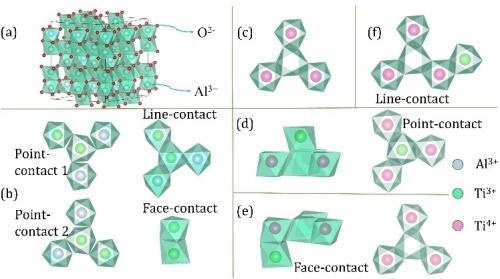May 24 2021
A group of researchers from the Shanghai Institute of Optics and Fine Mechanics (SIOM) of the Chinese Academy of Sciences recently came up with a new theory on the source of residual infrared absorption in Ti:sapphire laser crystals.

(a) The supercell structure of Al2O3, (b) four kinds of Ti3+-Ti3+ ion pair models, (c) 3Ti4+-VAl3- model, (d)~(f) three kinds of Ti3+-3Ti4+-VAl3- models. Image Credit: Shanghai Institute of Optics and Fine Mechanics.
The findings of the related study were published in the journal Photonics Research on May 4th, 2021.
Ti:sapphire (also known as Ti-doped α-Al2O3) is one of the three fundamental laser crystal materials. Since Ti:sapphire has outstanding chemical and physical, spectral and laser properties, it has been one of the main materials for developing super-intense ultrafast laser devices.
As the Ti:sapphire laser properties were reported in 1982, the residual infrared absorption (with maximum value about 800 nm), coincident with the laser emission band, has been the main challenge impacting its laser emission efficiency.
Thus, the determination of the origin of residual infrared absorption has been a hot study topic in the class of Ti:sapphire laser crystals.
In this research, the researchers carried out a systematic theoretical study on this main issue. With the analysis of the alumina’s crystal structure and the calculation of the optical and electronic properties of the probable ion pair defect models in Ti:sapphire, the near-infrared absorption spectra consistent well with the experiments was achieved, for the first time, by theoretical calculation.
At the same time, the microscopic mechanism that drives the residual absorption was successfully unraveled from the viewpoint of electron energy-level transition.
Scientists suggested a theory that the residual infrared absorption was collectively dominated by face-contact Ti4+-Ti3+ ion pair and the line-contact Ti3+-Ti3+ ion pair, which describe the doping concentration dependence, annealing characteristics and polarization characteristics of the residual infrared absorption noted by experiments.
By performing a range of experiments, scientists realized the theoretical traceability and breakthrough on the main issue, which impacts the laser emission efficiency of Ti:sapphire crystals. It is highly crucial for more studies and growth of Ti:sapphire laser crystals.
Besides, scientists noted that this study also offered a concept for screening new titanium doped laser matrix without any residual infrared absorption.
This study was financially supported by Strategic Priority Research Program of Chinese Academy of Sciences, National Key R&D Program of China, National Natural Science Foundation of China, and Shanghai Technical Trade Measures Response Special Project.
Journal Reference:
Gong, Q., et al. (2021) Theoretical study on residual infrared absorption of Ti:sapphire laser crystals. Photonics Research. doi.org/10.1364/PRJ.418395.